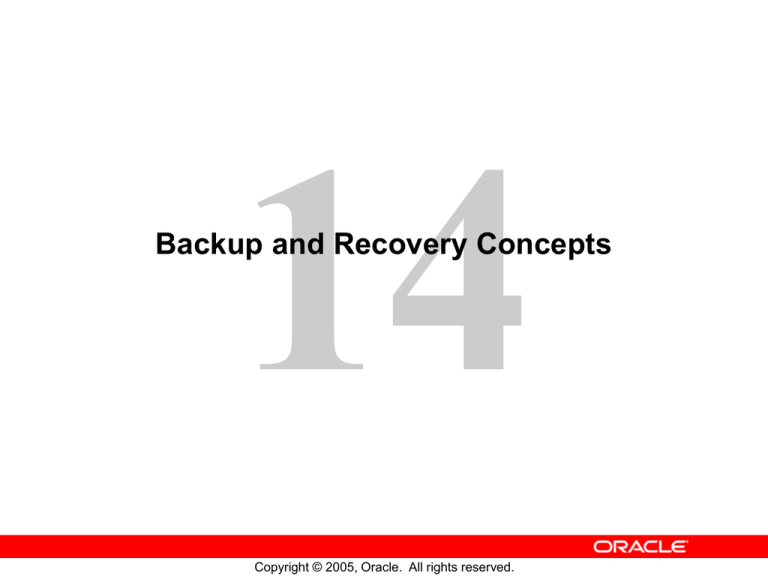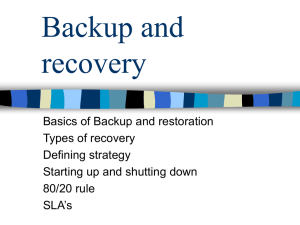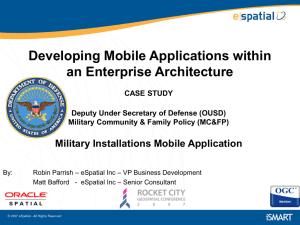
Backup and Recovery Concepts
Copyright © 2005, Oracle. All rights reserved.
Objectives
After completing this lesson, you should be able to do
the following:
• Identify the types of failure that may occur in an
Oracle database
• Describe ways to tune instance recovery
• Identify the importance of checkpoints, redo log
files, and archive log files
• Configure ARCHIVELOG mode
14-2
Copyright © 2005, Oracle. All rights reserved.
Part of Your Job
The administrator’s duties are to:
• Protect the database from failure wherever
possible
• Increase the Mean-Time-Between-Failures (MTBF)
• Decrease the Mean-Time-To-Recover (MTTR)
• Minimize the loss of data
14-3
Copyright © 2005, Oracle. All rights reserved.
Categories of Failures
Failures can generally be divided into the following
categories:
• Statement failure
• User process failure
• Network failure
• User error
• Instance failure
• Media failure
14-4
Copyright © 2005, Oracle. All rights reserved.
Statement Failure
Typical Problems
Possible Solutions
Attempts to enter invalid data Work with users to validate and
into a table
correct data.
14-5
Attempts to perform
operations with insufficient
privileges
Provide appropriate object or
system privileges.
Attempts to allocate space
that fail
• Enable resumable space
allocation.
• Increase owner quota.
• Add space to tablespace.
Logic errors in applications
Work with developers to correct
program errors.
Copyright © 2005, Oracle. All rights reserved.
User Process Failure
Typical Problems
Possible Solutions
A user performs an abnormal
disconnect.
A DBA’s action is not usually
needed to resolve user process
failures. Instance background
processes roll back
uncommitted changes and
release locks.
A user’s session is
abnormally terminated.
A user experiences a
program error that terminates
the session.
Watch for trends.
14-6
Copyright © 2005, Oracle. All rights reserved.
Network Failure
14-7
Typical Problems
Possible Solutions
Listener fails.
Configure a backup listener and
connect-time failover.
Network Interface Card (NIC)
fails.
Configure multiple network
cards.
Network connection fails.
Configure a backup network
connection.
Copyright © 2005, Oracle. All rights reserved.
User Error
Typical Causes
Possible Solutions
A user inadvertently
deletes or modifies data.
Roll back or use flashback query
to recover.
A user drops a table.
Recover table from the recycle
bin.
Oracle LogMiner
14-8
Copyright © 2005, Oracle. All rights reserved.
Instance Failure
Typical Causes
Possible Solutions
Power outage
Restart the instance by using the
“startup” command. Recovering
from instance failure is automatic,
including rolling forward changes
in the redo logs and then rolling
back any uncommitted
transactions.
Hardware failure
Failure of one of the
background processes
Emergency shutdown
procedures
14-10
Investigate the causes of failure
by using the alert log, trace files,
and Enterprise Manager.
Copyright © 2005, Oracle. All rights reserved.
Background Processes and Recovery:
Checkpoint (CKPT)
CKPT is responsible for:
• Signaling DBWn at checkpoints
• Updating data file headers with
checkpoint information
• Updating control files with
checkpoint information
Checkpoint
(CKPT)
SGA
Database
buffer cache
Database
Writer
(DBWn)
Control file
Data files
14-11
Copyright © 2005, Oracle. All rights reserved.
Background Processes and Recovery:
Redo Log Files and LogWriter
SGA
Redo log
buffer
LogWriter
(LGWR)
Redo log
group 1
14-12
Redo log
group 2
Redo log files:
• Record changes to the
database
• Should be multiplexed to
protect against loss
LogWriter writes:
• At commit
• When one-third full
Redo log
Group
3 • Every three seconds
group 3
• Before DBWn writes
Copyright © 2005, Oracle. All rights reserved.
Background Processes and Recovery:
Archiver (ARCn)
Archiver (ARCn):
• Is an optional
background process
• Automatically archives
online redo log files
when ARCHIVELOG mode
is set for the database
• Preserves the record of
all changes made to the
database
SGA
Redo log
buffer
LogWriter
(LGWR)
Archive
log files
Online
redo log
14-13
Copyright © 2005, Oracle. All rights reserved.
Archiver
(ARCn)
Instance Recovery
Instance or crash recovery:
• Is caused by attempts to open a database whose
files are not synchronized on shutdown
• Is automatic
• Uses information stored in redo log groups to
synchronize files
• Involves two distinct operations:
– Rolling forward: Data files are restored to their state
before the instance failed.
– Rolling back: Changes made but not committed are
returned to their original state.
14-14
Copyright © 2005, Oracle. All rights reserved.
Phases of Instance Recovery
Instance
1. Data files out of sync
SGA
2. Roll forward (redo)
Background
3. Committed and
processes
noncommitted data in files
4. Roll back (undo)
5. Committed data in files
Data file
Control file
SCN: 140
Redo log
group
SCN: 143
SCN 74-101
Undo
Data file
SCN: 129
Control file
SCN: 143
Redo log
group
SCN 102-143
Data file
SCN: 99
14-15
Copyright © 2005, Oracle. All rights reserved.
Database
Tuning Instance Recovery
•
•
During instance recovery, the transactions
between the checkpoint position and the end of
redo log must be applied to data files.
You tune instance recovery by controlling the
difference between the checkpoint position and
the end of redo log.
Checkpoint position
End of redo log
Instance recovery
Transactions
14-16
Copyright © 2005, Oracle. All rights reserved.
Using the MTTR Advisor
•
•
•
14-17
Specify the desired time in seconds or minutes.
The default value is 0 (disabled).
The maximum value is 3,600 seconds (one hour).
Copyright © 2005, Oracle. All rights reserved.
Media Failure
Typical Causes
Possible Solutions
Failure of disk drive
1. Restore the affected file from
backup.
2. If necessary, inform the
database about a new file
location.
3. If necessary, recover the file by
applying redo information.
Failure of disk controller
Deletion or corruption of
database file
14-18
Copyright © 2005, Oracle. All rights reserved.
Configuring for Recoverability
To configure your database for maximum
recoverability, you must:
• Schedule regular backups
• Multiplex control files
• Multiplex redo log groups
• Retain archived copies of redo logs
14-19
Copyright © 2005, Oracle. All rights reserved.
Control Files
Protect against database failure by multiplexing
control files. It is suggested that your database has:
• At least two copies (Oracle recommends three) of
the control file
• Each copy on a separate disk
• At least one copy on a separate disk controller
Control files
14-20
Copyright © 2005, Oracle. All rights reserved.
Redo Log Files
Multiplex redo log groups to protect against media
failure and loss of data. It is suggested that redo log
groups have:
• At least two members (files) per group
• Each member on a separate disk drive
• Each member on a separate disk controller
Note: Performance
is heavily
influenced
by writing to
redo logs.
14-21
Disk 1
Member
1
Member
2
Member
1
Disk 2
Member
2
Group 1
Member
1
Group 2
Member
2
Group 3
Copyright © 2005, Oracle. All rights reserved.
Multiplexing the Redo Log
14-22
Copyright © 2005, Oracle. All rights reserved.
Archive Log Files
To preserve redo information, create archived copies
of redo log files by performing the following steps.
1. Specify archive log file naming convention.
2. Specify one or more archive log file locations.
3. Switch the database to ARCHIVELOG mode.
Online redo log files
14-23
Archive log files
Copyright © 2005, Oracle. All rights reserved.
Archive Log File: Naming and Destinations
14-24
Copyright © 2005, Oracle. All rights reserved.
ARCHIVELOG Mode
•
To place the database in ARCHIVELOG mode,
perform the following steps:
1. Select the ARCHIVELOG Mode check box.
2. Click Apply. The database can be set to
ARCHIVELOG mode only from the MOUNT state.
3. Click Yes when asked whether you want to restart
the database.
4. Back up your database.
•
14-26
Databases in ARCHIVELOG mode have access to
the full range of backup and recovery options.
Copyright © 2005, Oracle. All rights reserved.
Summary
In this lesson, you should have learned how to:
• Identify the types of failure that may occur in an
Oracle database
• Describe ways to tune instance recovery
• Identify the importance of checkpoints, redo log
files, and archive log files
• Configure ARCHIVELOG mode
14-27
Copyright © 2005, Oracle. All rights reserved.
Practice Overview:
Configuring for Recoverability
This practice covers the following topics:
• Multiplexing control files
• Multiplexing redo log groups
• Placing your database in ARCHIVELOG mode
•
14-28
Ensuring that redundant archive logs are created
Copyright © 2005, Oracle. All rights reserved.







